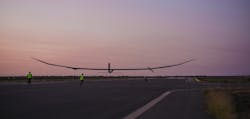BAE's PHASA-35 solar powered endurance flyer has the potential to stay airborne for a year
WOOMERA, Australia - BAE has announced that its Persistent High Altitude Solar Aircraft (PHASA-35) has successfully completed its maiden flight. The company says the aircraft is "plugging the gap between aircraft and satellite technology."
PHASA-35 has been designed, built and now flown in less than two years as part of a collaboration between BAE and Prismatic Ltd, which BAE had agreed to acquire last year. Designed to operate unmanned in the stratosphere, above the weather and conventional air traffic, PHASA-35 offers a persistent and affordable alternative to satellites combined with the flexibility of an aircraft, which could be used for a range of valuable applications including forest fire detection and maritime surveillance.
Sponsored by the UK’s Defence Science and Technology Laboratory (DSTL) and Australian Defence Science and Technology Group (DSTG), the successful flight trials took place at the Royal Australian Air Force (RAAF) Woomera Test Range in South Australia.
The trials marked the first fully integrated flight test of the PHASA-35 system, delivering proof of capability from design to flight in 20 months.
As a High Altitude Long Endurance (HALE) vehicle, PHASA-35 is powered by the Sun during the day and by batteries overnight. The long-life battery and highly efficient solar technology could allow the aircraft to maintain flight for up to a year operating in the stratosphere, the upper regions of the Earth’s atmosphere.
PHASA-35 is designed to provide a persistent, stable platform for monitoring, surveillance, communications and security applications. When connected to other technologies and assets, it will provide both military and commercial customers with capabilities that are not currently available from existing air and space platforms. The unmanned air vehicle also has the potential to be used in the delivery of communications networks including 5G, as well as provide other services, such as disaster relief and border protection, at a fraction of the cost of satellites.
